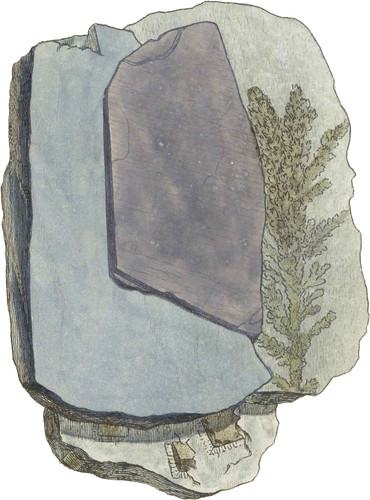 Enlarge
Enlarge
British Mineralogy
Common Argillaceous Slate, or Schistus
- Class 2. Earths.
- Order 2. Aggregate.
- Syn.
- Schistus. Linn. Syst. ed. 13. 3. 37.
- Argillite. Kirw. 354.
- Argile schisteuse. Haüy, 4. 446.
- Clay Slate. Jameson’s Mineral. 1. 334.
The Slate commonly known as of a slate-grey colour is found in many places in Great Britain, from Penzance in Cornwall, through Wales and Westmoreland to the Caltort Hill in Scotland, where there are primitive rocks. Between the different beds of Slate which lie in that direction are beds of Lime-slate, as at Plymouth-Dock, where one side is Slate and the other Limestone. Many parts of Scotland, and Wicklow in Ireland, abound with this substance, and some afford much variety. Lord Penryn’s, at Nanfrancon near Bangor, is quarried in large quantities for London; the dark grey and lighter sorts are used for slating houses, and the less fissile ones serve for posts, or turning into candlesticks and fanciful ornaments. Coat buttons have been made, of Slate, which proved very durable, and often suited well with a dark, or light brown, or gray, or mottled coat.
The front figure shows the durable Slate of Cornwall, which is used in as thin and light plates as any. It has a close, glossy, and nearly even appearance, and consists chiefly of Chlorite with an intimate mixture of Quartz, upon which it depends for its durability, as it probably does upon the different degrees of oxidization of the Iron contained in it for the shades of colour. Killas and all the schistose rocks in Cornwall are only different varieties of this substance, depending upon the Talc, Quartz, &c., being somewhat varied in quantity and texture; which variation may easily be supposed innumerable, but which may without much practice be recognized, although the word Killas seems to have caused some confusion.
The lowest figure is Slate from Ingleborough*, in Yorkshire; and, like the Irish, Welsh, and Scotch Slates, often have cubes of Pyrites in them.
The present specimen is one of that sort, and has a newly-noticed substance on two sides of the Pyrites. We have mentioned it to many friends, but can neither gain intelligence about it, nor learn whether it is to be had in better specimens. This is somewhat like Asbestus, the fibres being at right angles with the Pyrites on two sides only.
The left hand is a specimen from Westmoreland.
- * This place is famous for dendritical Pyrites on the Slate, forming as it were golden trees (see right hand figure).

